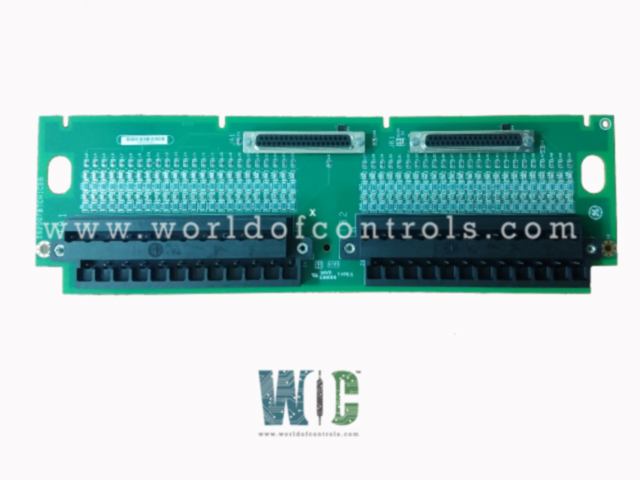
World Of Controls understands the criticality of your requirement and works towards reducing the lead time as much as possible.
IS200TBTCH1C - Thermocouple Input Terminal Board is available in stock which ships the same day.
IS200TBTCH1C - Thermocouple Input Terminal Board comes in UNUSED as well as REBUILT condition.
To avail our best deals for IS200TBTCH1C - Thermocouple Input Terminal Board, contact us and we will get back to you within 24 hours.
SPECIFICATIONS:
Part Number: IS200TBTCH1C
Manufacturer: General Electric
Series: Mark VIe
Product Type: Thermocouple Input Terminal Board
Number of channels: 24 channels
Thermocouple types: E, J, K, S, T
Span: -8 mV to +45 mV
Operating temperature: 0 to +45°C
Size: 15.9 cm high x 17.8 cm
Repair: 3-7 Day
Availability: In Stock
Country of Origin: United States
Manual: GEH-6421M
FUNCTIONAL DESCRIPTION:
IS200TBTCH1C is a Thermocouple Input Terminal Board manufactured and designed by General Electric as part of the Mark VIe Series used in GE Distributed Turbine Control Systems. The thermocouple terminal board accommodates up to 24 thermocouple inputs of types E, J, K, S, or T. These inputs are connected to two barrier-type blocks on the terminal board, and communication with the I/O processor is established through DC-type connectors. In the Mark VIe system, the PTCC I/O pack collaborates with the board, supporting simplex, dual, and TMR (Triple Modular Redundant) systems. In simplex configurations, two PTCC packs can be plugged into the TBTCH1C, providing a total of 24 inputs. When using the TBTCH1B, one, two, or three PTCC packs can be connected, supporting a range of system setups, although only 12 inputs are accessible in this configuration.
INSTALLATION:
Mounting Removable Terminal Blocks: The installation process begins by mounting the removable terminal blocks onto the thermocouple terminal board. These blocks serve as the pivotal connection points for the thermocouples within the system. Securing them in place with two screws ensures stability and a dependable connection.
Connecting Thermocouples: Thermocouples, essential temperature sensors, are then wired directly to the terminals on these blocks. Each terminal block comprises 24 terminals capable of accommodating wires up to 12 AWG in size. These terminals provide a secure attachment point for the wires originating from the thermocouples, ensuring a reliable connection.
Shield Terminal Strip for Grounding: Positioned on the left side of each terminal block is a shield terminal strip that connects to the chassis ground. This component assumes a critical role in grounding and shielding the thermocouple wires, mitigating interference, and preserving the accuracy of temperature measurements.
Cabling in Mark VIe Systems: For Mark VIe systems, the connection setup involves I/O packs that plug directly into the J-type connectors on the thermocouple terminal board. The number of cables or I/O packs utilized depends on the desired level of redundancy for the system. Redundancy ensures system reliability by providing backup components, contributing to uninterrupted operations.
OPERATION:
Flexibility with Thermocouple Inputs: It offers remarkable flexibility as it can accommodate 24 thermocouple inputs, whether they are grounded or ungrounded. This adaptability allows it to work effectively with a variety of temperature-sensing setups.
Long-Distance Connectivity: One notable feature is its ability to handle thermocouple inputs located up to 300 meters (approximately 984 feet) away from the turbine control panel. This long-distance capability enables the placement of temperature sensors in various parts of the system while maintaining reliable communication with the control panel.
Cable Resistance Tolerance: To ensure accurate and dependable data transmission, it is designed to tolerate a maximum two-way cable resistance of 450 ohms. This tolerance ensures that cable length and resistance variations do not compromise the quality of the temperature data collected.
High-Frequency Noise Suppression: Noise in electrical signals can interfere with temperature measurements. TBTC addresses this concern by incorporating high-frequency noise suppression mechanisms. These mechanisms help filter out unwanted electrical noise, ensuring that the temperature readings remain precise and free from interference.
Cold Junction Reference Devices: Equipped with two cold junction reference devices These devices are essential for compensating for temperature variations at the junction where the thermocouple wires connect to the terminal blocks. By providing reference points, they enable accurate temperature measurements, even in varying environmental conditions.
Analog-to-Digital Conversion in the I/O Processor: The analog-to-digital conversion process, which translates analog temperature signals into digital data, occurs in the I/O processor. This step is vital in preparing the temperature readings for further processing and analysis.
WOC has the largest stock of GE Speedtronic Control System Replacement Parts. We can also repair your faulty boards. WORLD OF CONTROLS can also supply unused and rebuilt backed-up with a warranty. Our team of experts is available round the clock to support your OEM needs. Our team of experts at WOC is happy to assist you with any of your automation requirements. For pricing and availability on any parts and repairs, kindly get in touch with our team by phone or email.
How many thermocouple inputs can it accommodate, and what types of thermocouples are supported?
It can accommodate up to 24 thermocouple inputs, and it is compatible with various thermocouple types, including E, J, K, S, or T.
How are the thermocouple inputs connected, and how is communication with the I/O processor established?
The thermocouple inputs are connected to two barrier-type blocks on the terminal board. Communication with the I/O processor is established through DC-type connectors, ensuring data transfer and integration with the control system.
When using the TBTCH1B, how many PTCC packs can be connected, and how does this affect the number of available inputs?
When using the board, one, two, or three PTCC packs can be connected, offering flexibility in system setups. However, in this configuration, only 12 inputs are accessible, making it suitable for specific applications.